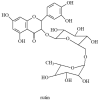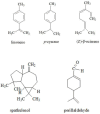Goutweed (Aegopodium podagraria L.)-An Edible Weed with Health-Promoting Properties
- PMID: 40286209
- PMCID: PMC11990176
- DOI: 10.3390/molecules30071603
Goutweed (Aegopodium podagraria L.)-An Edible Weed with Health-Promoting Properties
Abstract
Goutweed (Aegopodium podagraria L.) is a species of medicinal perennial in the celery family (Apiaceae), also considered an edible plant with medicinal effects and high nutritional value. In traditional folk medicine, it was known as a remedy for gout (arthritis) and also used to relieve rheumatism or sciatica. The botanical characteristics, occurrence, nutritional composition, and traditional and present-day applications of this plant are discussed. Furthermore, the important specific plant metabolites including organic acids and their derivatives, flavonoids, coumarins, polyacetylenes and terpene components of essential oil are presented and their biological activity is described. The valuable medicinal properties of Aegopodium podagria L. include anti-inflammatory, antirheumatic, antioxidant, antibacterial, antifungal, diuretic, sedative and protective effects on the kidneys and liver. The aim of this paper was to describe, on the basis of the available literature, the chemical composition, bioactivity and health-promoting properties of this wild edible plant. The information obtained is described and summarized in tables.
Keywords: Aegopodium podagraria L.; bioactivity; biologically active compounds; goutweed; ground elder.
Conflict of interest statement
The authors declare no conflicts of interest.
Figures










Similar articles
-
Bioactive Compounds in Aegopodium podagraria Leaf Extracts and Their Effects against Fluoride-Modulated Oxidative Stress in the THP-1 Cell Line.Pharmaceuticals (Basel). 2021 Dec 20;14(12):1334. doi: 10.3390/ph14121334. Pharmaceuticals (Basel). 2021. PMID: 34959734 Free PMC article.
-
The [DPPH●/DPPH-H]-HPLC-DAD Method on Tracking the Antioxidant Activity of Pure Antioxidants and Goutweed (Aegopodium podagraria L.) Hydroalcoholic Extracts.Molecules. 2020 Dec 18;25(24):6005. doi: 10.3390/molecules25246005. Molecules. 2020. PMID: 33353137 Free PMC article.
-
The influence of goutweed (Aegopodium podagraria L.) tincture and metformin on the carbohydrate and lipid metabolism in dexamethasone-treated rats.BMC Complement Altern Med. 2016 Jul 22;16:235. doi: 10.1186/s12906-016-1221-y. BMC Complement Altern Med. 2016. PMID: 27450405 Free PMC article.
-
Traditionally Used Edible Flowers as a Source of Neuroactive, Antioxidant, and Anti-Inflammatory Extracts and Bioactive Compounds: A Narrative Review.Molecules. 2025 Feb 4;30(3):677. doi: 10.3390/molecules30030677. Molecules. 2025. PMID: 39942781 Free PMC article. Review.
-
Aliphatic C(17)-polyacetylenes of the falcarinol type as potential health promoting compounds in food plants of the Apiaceae family.Recent Pat Food Nutr Agric. 2011 Jan;3(1):64-77. doi: 10.2174/2212798411103010064. Recent Pat Food Nutr Agric. 2011. PMID: 21114468 Review.
References
-
- Kyrbassova E.A., Baitasheva G.U., Danilov M.P., Dyuskaliyeva G.U., Abdrasulova Z., Adenova B.E., Saparov A. Anatomical-Morphological and Phytochemical Study of Medicinal Plant Aegopodium podagraria L. Growing in Kazakhstan. Int. J. Pharm. Res. 2018;10:689–697.
-
- Valyova M., Tashev A., Stoyanov S., Yordanova S., Ganeva Y. In Vitro Free-Radical Scavenging Activity of Aegopodium podagraria L. and Orlaya grandiflora (L.) Hoffm. (Apiaceae) J. Chem. Technol. Metall. 2016;51:271–274.
Publication types
MeSH terms
Substances
LinkOut - more resources
Full Text Sources

